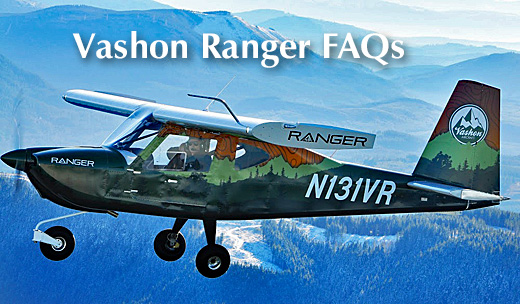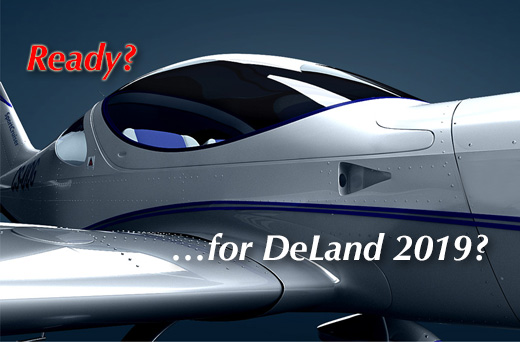
In about one week, it all ends. Before then, DeLand Showcase 2019 is set to begin! As this is the last airshow of the year, it’s also fair to say the season ends when DeLand show concludes. This year is the fourth annual event. Since the Sebring show bid a final farewell last spring, DeLand will be the last light aircraft show until Arizona’s Copperstate/Buckeye Air Fair in February, followed two months later by Sun ‘n Fun. If you live in the eastern half of the USA, DeLand and Sun ‘n Fun are separated by five months. Yikes! You can learn more about Copperstate/Buckeye in this video with the Vice Mayor. Next week on November 14-15-16, welcome to sunny, warm Florida. Come to DeLand I hope many of you who frequent this website will be heading to DeLand for the event starting next Thursday.


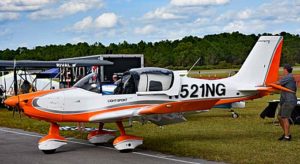 Since the Sebring show bid a final farewell last spring, DeLand will be the last light aircraft show until Arizona's
Since the Sebring show bid a final farewell last spring, DeLand will be the last light aircraft show until Arizona's 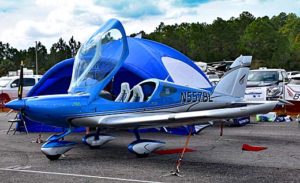 In the previous runnings of the DeLand Showcase, weather has been not just good but spectacularly good. One late afternoon last year experienced rain and some wind — after a full day of decent weather. However, every other day of DeLand has enjoyed temperatures in the low 80s (close to 30° for you Centigrade users) under sunny skies and with plenty of vendors to keep you looking (list below).
Show Director Jana Filip, her husband Gary, airport manager John Eiff, and a significant army of volunteers do a marvelous job making sure things are set up right and run well during the event. Doing the bulk of the planning, Jana and Gary reveal years of experience, building in short order a new event that seems like it has ample experience. This is no big surprise as Jana was in charge of the Sebring Sport Aviation Expo for several years before being lured away by the City of DeLand to start up and run their new event.
In the previous runnings of the DeLand Showcase, weather has been not just good but spectacularly good. One late afternoon last year experienced rain and some wind — after a full day of decent weather. However, every other day of DeLand has enjoyed temperatures in the low 80s (close to 30° for you Centigrade users) under sunny skies and with plenty of vendors to keep you looking (list below).
Show Director Jana Filip, her husband Gary, airport manager John Eiff, and a significant army of volunteers do a marvelous job making sure things are set up right and run well during the event. Doing the bulk of the planning, Jana and Gary reveal years of experience, building in short order a new event that seems like it has ample experience. This is no big surprise as Jana was in charge of the Sebring Sport Aviation Expo for several years before being lured away by the City of DeLand to start up and run their new event.
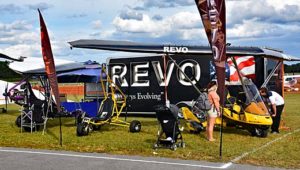 In addition to the Showcase event, DeLand is creating a
In addition to the Showcase event, DeLand is creating a 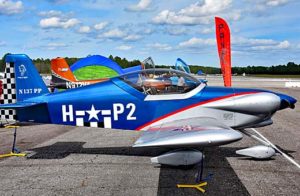 Follow this link to see all exhibitors
Follow this link to see all exhibitors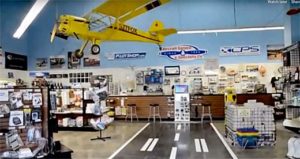
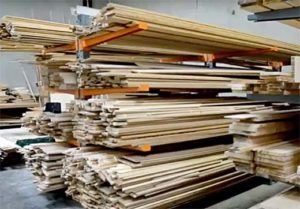
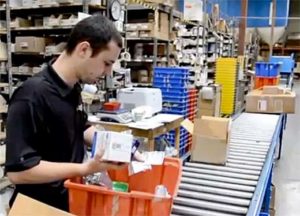

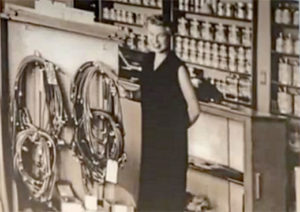

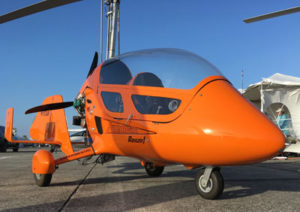 "No dice," said FAA! With perspective, it turned out only a small group was opposed but so strong was their hand at the time that FAA leadership could not break the logjam. Now, that appears to be solved. I write "appears" as we won't know for certain until FAA releases their NPRM on the program widely known as MOSAIC. Best guess, this won't come for at least a couple more years but the plans inside FAA are maintaining support at the highest levels of the agency and that gyroplane logjam definitely appears to be loosening. Amen! That was a long time coming.
Maybe you don't care. Maybe you aren't interested in rotor-winged aircraft. I didn't think I was either until I flew a few of these and most recently got some worthy instruction from Greg Spicola, who does gyro flight instruction and transition training for SilverLight.
"No dice," said FAA! With perspective, it turned out only a small group was opposed but so strong was their hand at the time that FAA leadership could not break the logjam. Now, that appears to be solved. I write "appears" as we won't know for certain until FAA releases their NPRM on the program widely known as MOSAIC. Best guess, this won't come for at least a couple more years but the plans inside FAA are maintaining support at the highest levels of the agency and that gyroplane logjam definitely appears to be loosening. Amen! That was a long time coming.
Maybe you don't care. Maybe you aren't interested in rotor-winged aircraft. I didn't think I was either until I flew a few of these and most recently got some worthy instruction from Greg Spicola, who does gyro flight instruction and transition training for SilverLight.
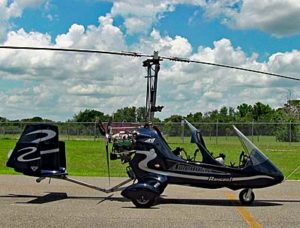 Abid Farooqui's
Abid Farooqui's 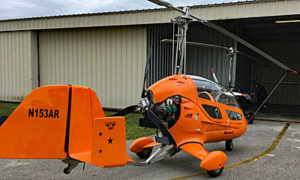 Along came European developers like Italy's Magni Gyro and Germany's AutoGyro, followed by several others. They made numerous improvements but among them was the now-standard tailplane located further aft and with more vertical area. That and better pilot preparation resulted in a much better safety record and European pilots began to embrace these aircraft.
Sales took off, so much so that leading engine producer Rotax reported more 9-series engines were being sold to gyroplane builders than any other aircraft subgroup. American entrepreneurs took note, Abid Farooqui's SilverLight among them.
Along came European developers like Italy's Magni Gyro and Germany's AutoGyro, followed by several others. They made numerous improvements but among them was the now-standard tailplane located further aft and with more vertical area. That and better pilot preparation resulted in a much better safety record and European pilots began to embrace these aircraft.
Sales took off, so much so that leading engine producer Rotax reported more 9-series engines were being sold to gyroplane builders than any other aircraft subgroup. American entrepreneurs took note, Abid Farooqui's SilverLight among them.
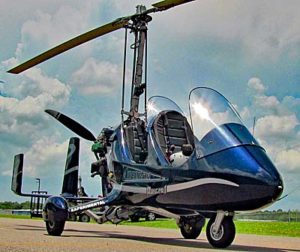 The video below conveys more information I learned in a training session with Greg in the fully enclosed
The video below conveys more information I learned in a training session with Greg in the fully enclosed 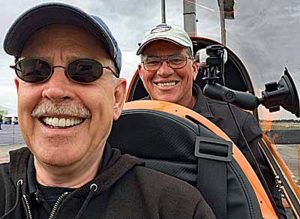 That said, FAA is to be commended for finally including fully built Special LSA gyroplanes in their proposed new regulation.
Given their general ease of operation, excellent performance in winds too strong for some light aircraft, compact storage in a hangar or trailer, and the relatively modest cost of acquiring a gyroplane, it seems likely we will see more of these aircraft in the years ahead.
Here's our Video Pilot Report flying the SilverLight AR-1 Ranger with full enclosure:
https://youtu.be/qIJPGX0G1Tc
That said, FAA is to be commended for finally including fully built Special LSA gyroplanes in their proposed new regulation.
Given their general ease of operation, excellent performance in winds too strong for some light aircraft, compact storage in a hangar or trailer, and the relatively modest cost of acquiring a gyroplane, it seems likely we will see more of these aircraft in the years ahead.
Here's our Video Pilot Report flying the SilverLight AR-1 Ranger with full enclosure:
https://youtu.be/qIJPGX0G1Tc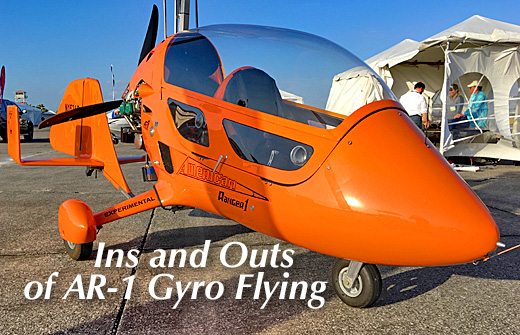
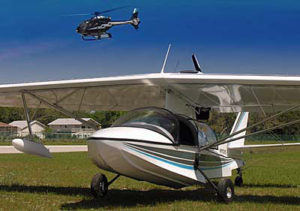 First, a caveat: While FAA is communicating some of the
First, a caveat: While FAA is communicating some of the 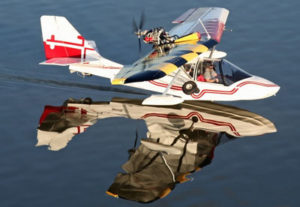
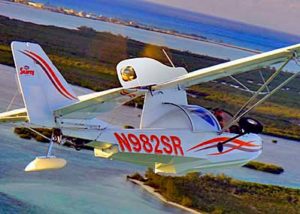 Michael Stock said, "In general, all propellers which are not in-flight adjustable are a compromise between take-off and climb performance (power) and cruise flight (speed, endurance). They cannot work at maximum efficiency in both flight regimes."
He added, "Propeller thrust for take-off and climb can be up to 30% higher if the propeller blade angle is perfectly adjusted at all times."
The problem is that FAA, by regulation in place since 2004, only allows a ground-adjustable prop. The agency's thinking 15 years ago revolved around "safe, simple, easy to fly" intended for all aircraft in the LSA category. That philosophy has not changed; they continue to repeat the line as a guide to their proposed regulation.
However, a ground adjustable prop can be done poorly. Mistakes can be made if the person making the adjustment does not have training or experience.
Michael Stock said, "In general, all propellers which are not in-flight adjustable are a compromise between take-off and climb performance (power) and cruise flight (speed, endurance). They cannot work at maximum efficiency in both flight regimes."
He added, "Propeller thrust for take-off and climb can be up to 30% higher if the propeller blade angle is perfectly adjusted at all times."
The problem is that FAA, by regulation in place since 2004, only allows a ground-adjustable prop. The agency's thinking 15 years ago revolved around "safe, simple, easy to fly" intended for all aircraft in the LSA category. That philosophy has not changed; they continue to repeat the line as a guide to their proposed regulation.
However, a ground adjustable prop can be done poorly. Mistakes can be made if the person making the adjustment does not have training or experience.
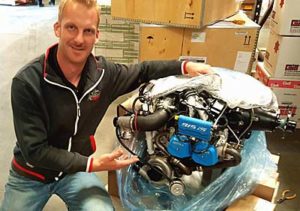
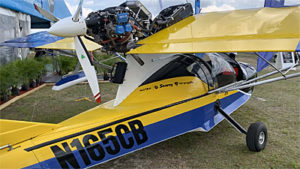
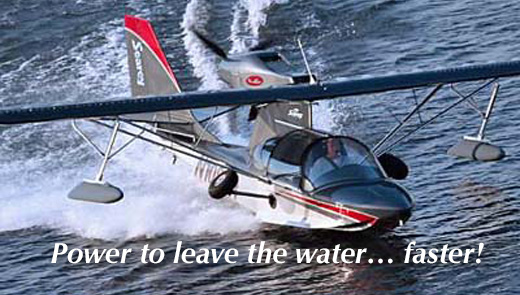
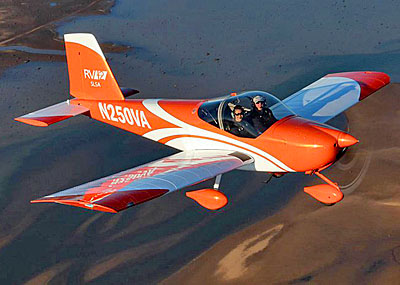 If you follow light aviation intently as many readers do, knowing what aircraft and subgroups (within LSA and SP kits
If you follow light aviation intently as many readers do, knowing what aircraft and subgroups (within LSA and SP kits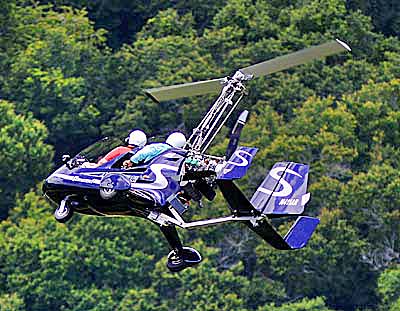 Why? We don't claim to have all the answers but regular surveying of exhibitors at airshows revealed that many sellers say, "The market is good. People are buying." Of course, this is anecdotal not scientific but we heard it from enough vendors to believe they're feeling good about their enterprises. Many pilots backed up this finding with their own, personal assessment.
If you want to do your own analysis, you certainly can using our completely free-of-charge
Why? We don't claim to have all the answers but regular surveying of exhibitors at airshows revealed that many sellers say, "The market is good. People are buying." Of course, this is anecdotal not scientific but we heard it from enough vendors to believe they're feeling good about their enterprises. Many pilots backed up this finding with their own, personal assessment.
If you want to do your own analysis, you certainly can using our completely free-of-charge 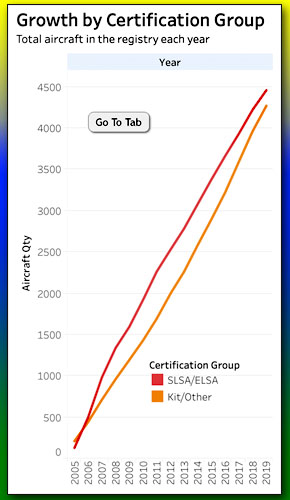 This is the first time you've seen this because earlier, we segmented SLSA from ELSA from SP kits. This made it appear kits were growing faster than the LSA groups. In fact, they are nearly matched with kit-built aircraft.
Viewing all light aircraft as a group, Steve noted, "The same six brands continue to lead the pack." He refers to the full fleet of light aircraft a Sport Pilot may fly — led by kit-built aircraft producers: Zenair/Zenith, Van's, Rans, Sonex, and Kitfox plus SLSA builder,
This is the first time you've seen this because earlier, we segmented SLSA from ELSA from SP kits. This made it appear kits were growing faster than the LSA groups. In fact, they are nearly matched with kit-built aircraft.
Viewing all light aircraft as a group, Steve noted, "The same six brands continue to lead the pack." He refers to the full fleet of light aircraft a Sport Pilot may fly — led by kit-built aircraft producers: Zenair/Zenith, Van's, Rans, Sonex, and Kitfox plus SLSA builder, 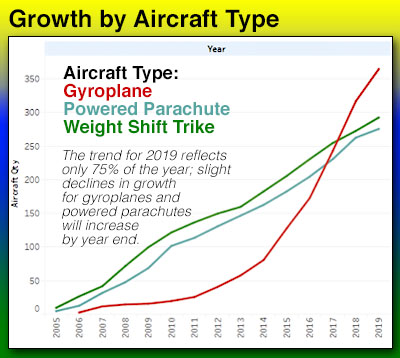 Using
Using 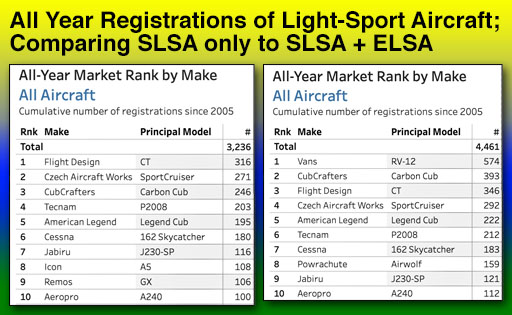 However, fixed wing continue to be, by far, the biggest group of LSA (partly as very few kit-built aircraft are "alternative" types).
Among Special (fully built) LSA, Flight Design continues atop the ranking. They enjoyed a phenomenal start back in 2005-2006 and have never lost their leadership position. American Legend, Czech Sport Aircraft, CubCrafters, Tecnam, and
However, fixed wing continue to be, by far, the biggest group of LSA (partly as very few kit-built aircraft are "alternative" types).
Among Special (fully built) LSA, Flight Design continues atop the ranking. They enjoyed a phenomenal start back in 2005-2006 and have never lost their leadership position. American Legend, Czech Sport Aircraft, CubCrafters, Tecnam, and 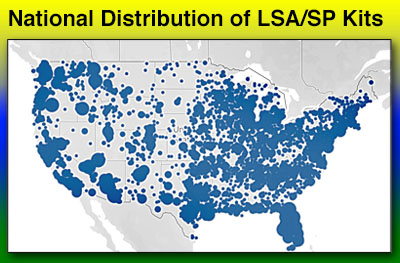 As we head into the final quarter of 2019 — and the final LSA show of the year, the
As we head into the final quarter of 2019 — and the final LSA show of the year, the 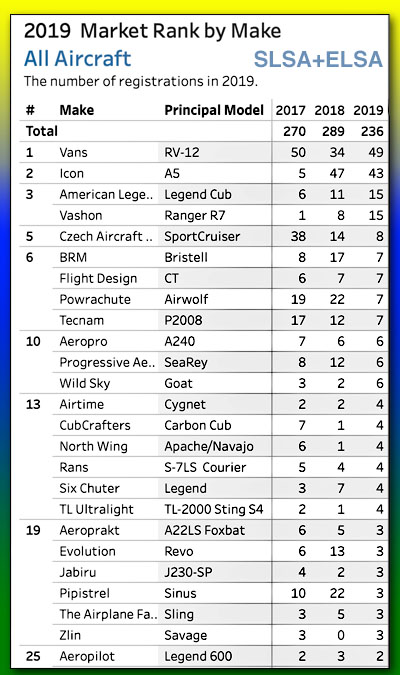
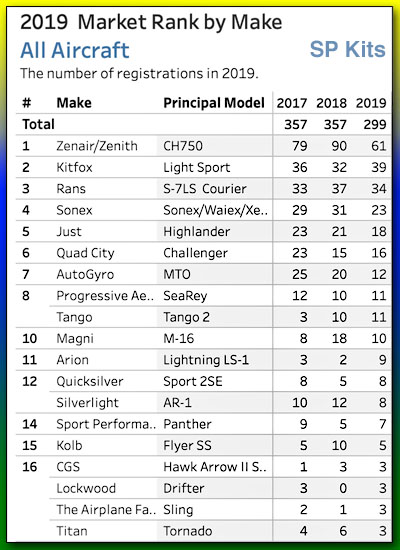

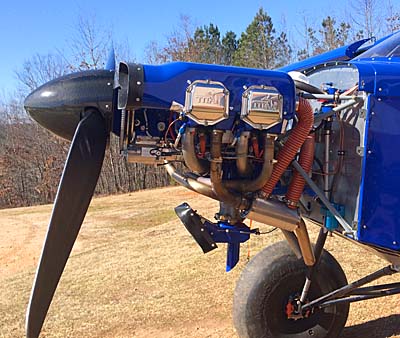
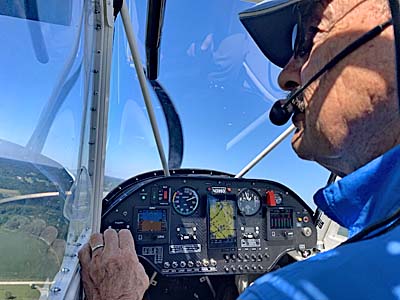 Referring to these flying machines is a way of showing the keen interest many pilots have in airplanes that somewhat resemble Piper's 1940s-era Cub series. Into this enthusiasts' heaven comes Shock Ultra, with its
Referring to these flying machines is a way of showing the keen interest many pilots have in airplanes that somewhat resemble Piper's 1940s-era Cub series. Into this enthusiasts' heaven comes Shock Ultra, with its 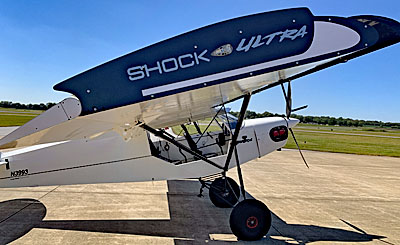 Shock Ultra has some features not found on all Zlin's other models, including double slotted Fowler flaps that help lower stall speed to almost absurdly-slow levels (for proof with your own eyes, see our video below). In addition, Shock Ultra has leading edge wing slats though these, like the "Shock options" for the Titan-powered Shock Outback, are optional. The newest variation of this design uses the oversized outboard shock absorbers similar to those first seen on SuperSTOL and then Shock Outback. They are "to tame the landings," said SportairUSA. All these design qualities combine to provide good visibility on approach thanks to a "flattened landing flare."
Indeed, this all works, resulting in a "stall speed of 18 mph (solo) and 24 mph (dual)." Note that's miles an hour, not knots (15.6 and 20.8 knots respectively). It felt rather amazing to witness an airspeed indicator bumping down toward zero while we flew near gross weight.
Shock Ultra has some features not found on all Zlin's other models, including double slotted Fowler flaps that help lower stall speed to almost absurdly-slow levels (for proof with your own eyes, see our video below). In addition, Shock Ultra has leading edge wing slats though these, like the "Shock options" for the Titan-powered Shock Outback, are optional. The newest variation of this design uses the oversized outboard shock absorbers similar to those first seen on SuperSTOL and then Shock Outback. They are "to tame the landings," said SportairUSA. All these design qualities combine to provide good visibility on approach thanks to a "flattened landing flare."
Indeed, this all works, resulting in a "stall speed of 18 mph (solo) and 24 mph (dual)." Note that's miles an hour, not knots (15.6 and 20.8 knots respectively). It felt rather amazing to witness an airspeed indicator bumping down toward zero while we flew near gross weight.
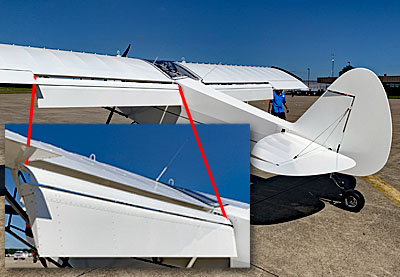 Those low speeds are aided by a basic empty weight of 725 pounds. This is more than 100 pounds lighter than some Cub clones from CubCrafters and American Legend. As many experienced light aircraft pilots believe, the lighter the airframe the better it performs and handles and the more payload you can carry onboard.
Another proof of Zlin designer Pascale Russo's diligent effort to reduce weight and simplify is that Shock Ultra performs admirably with the Rotax 912 or 914, while the heavier competing models appear to require bigger engines, which add more weight, burn more fuel, and cost more.
Shock Ultra is not the lowest-priced model SportairUSA offers, though it is less than the Titan-powered Shock Outback. However, if its final figure —
Those low speeds are aided by a basic empty weight of 725 pounds. This is more than 100 pounds lighter than some Cub clones from CubCrafters and American Legend. As many experienced light aircraft pilots believe, the lighter the airframe the better it performs and handles and the more payload you can carry onboard.
Another proof of Zlin designer Pascale Russo's diligent effort to reduce weight and simplify is that Shock Ultra performs admirably with the Rotax 912 or 914, while the heavier competing models appear to require bigger engines, which add more weight, burn more fuel, and cost more.
Shock Ultra is not the lowest-priced model SportairUSA offers, though it is less than the Titan-powered Shock Outback. However, if its final figure — 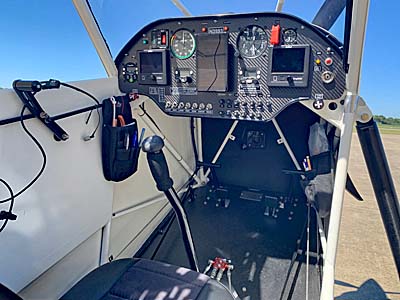 Cub-like models from Zlin include the very affordable
Cub-like models from Zlin include the very affordable 

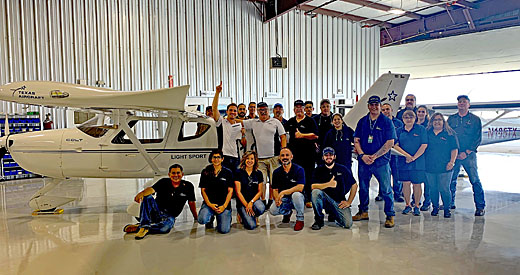 I toured the company's aircraft production facilities in Hondo and found them able to match other strong operations I have visited. The company has wisely hired outside talent as needed, for example, to gain their Special airworthiness certificate. It was clear to me that, although a lot of paper documentation had to be correct, this Brazilian-founded but Texas-operated company would have no trouble proving their compliance to all applicable standards.
Congratulations to CEO Matheus Grande, designer Caio Jordão, and their coworkers at Texas Aircraft for this success.
I toured the company's aircraft production facilities in Hondo and found them able to match other strong operations I have visited. The company has wisely hired outside talent as needed, for example, to gain their Special airworthiness certificate. It was clear to me that, although a lot of paper documentation had to be correct, this Brazilian-founded but Texas-operated company would have no trouble proving their compliance to all applicable standards.
Congratulations to CEO Matheus Grande, designer Caio Jordão, and their coworkers at Texas Aircraft for this success.
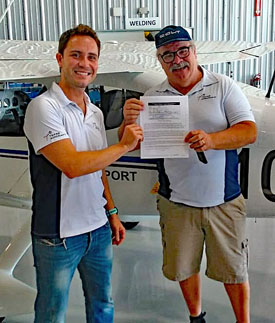
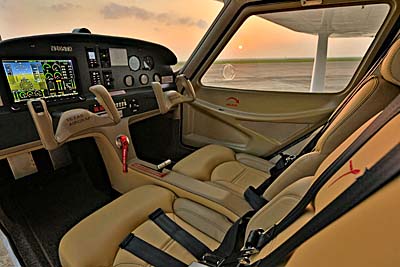
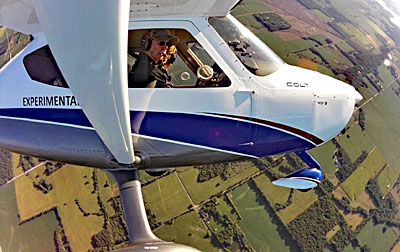

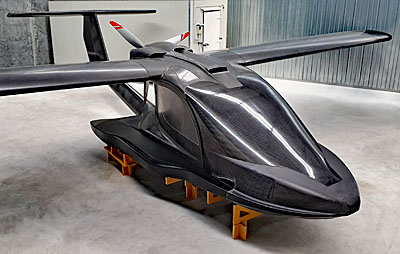 You might think those words don't apply to many Light-Sport Aircraft. Certainly, "big" is not a word most pilots associate with LSA. A number are actually rather compact, though with standardized rules, aircraft parameters don't differ as much as some might think.
Wave is different …at least in one particular way. The newest LSA seaplane in development in the Southern Hemisphere has something special. What is it?
Vickers recently announced winning a weight increase exemption for their deluxe Wave. As other producers wait to read FAA's coming regulation regarding aircraft size, Wave can begin leveraging their higher gross weight to increase capability and power.
Principal Paul Vickers stated, "After many months we can finally announce that Vickers Aircraft has received our FAA weight exemption for the Wave™ LSA. This will allow a MTOW of 1,850 pounds (839 kilograms), so we can incorporate additional safety features that will set the Wave apart and help us achieve our long-term goal of moving aviation forward." He added, "Some of these safety features include water maneuvering thruster, CrossOver Landing gear, increased horsepower, and the required fuel capacity to ensure the Wave is operated safely and can perform its mission."
Paul continued, "We have designed the Wave for this increased MTOW and have incorporated the required additional structure." He feels this sets up Wave to smoothly transition into the LSA rule changes that are on the horizon, new definitions that will include adjustments regarding the weight of Light-Sport Aircraft.
You might think those words don't apply to many Light-Sport Aircraft. Certainly, "big" is not a word most pilots associate with LSA. A number are actually rather compact, though with standardized rules, aircraft parameters don't differ as much as some might think.
Wave is different …at least in one particular way. The newest LSA seaplane in development in the Southern Hemisphere has something special. What is it?
Vickers recently announced winning a weight increase exemption for their deluxe Wave. As other producers wait to read FAA's coming regulation regarding aircraft size, Wave can begin leveraging their higher gross weight to increase capability and power.
Principal Paul Vickers stated, "After many months we can finally announce that Vickers Aircraft has received our FAA weight exemption for the Wave™ LSA. This will allow a MTOW of 1,850 pounds (839 kilograms), so we can incorporate additional safety features that will set the Wave apart and help us achieve our long-term goal of moving aviation forward." He added, "Some of these safety features include water maneuvering thruster, CrossOver Landing gear, increased horsepower, and the required fuel capacity to ensure the Wave is operated safely and can perform its mission."
Paul continued, "We have designed the Wave for this increased MTOW and have incorporated the required additional structure." He feels this sets up Wave to smoothly transition into the LSA rule changes that are on the horizon, new definitions that will include adjustments regarding the weight of Light-Sport Aircraft.
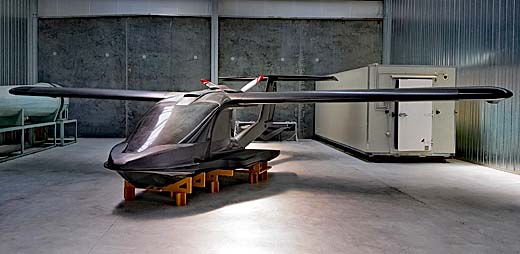 "The aviation industry is known for its high barriers to entry," said Paul. "While everyone sees the final product (the aircraft) flying, what they don’t see are the years of work that go into the company structure behind it." Vickers related tasks to meet business regulations plus health and safety requirements, environmental considerations, design, flight and manufacturing criteria as well as aviation authority regulations prior to the first aircraft even operating.
"With this in mind, the last 12 months has seen Vickers not only progress the aircraft design but also move into an employment phase to bring in the necessary people to meet all of our regulatory requirements," Paul explained. He said this means a doubling of the Engineering (Design) Team numbers and the employment of a Quality and Systems Manager.
Increased staffing levels allowed engineering to move into the stress testing phase of the design program to prove the strength of the design. This phase includes physical coupon testing to demonstrate Vickers can manufacture the parts to the design strengths and to verify our structural analysis. "This phase has to be completed before the flight test aircraft is manufactured to ensure it operates as expected," Paul noted.
"The aviation industry is known for its high barriers to entry," said Paul. "While everyone sees the final product (the aircraft) flying, what they don’t see are the years of work that go into the company structure behind it." Vickers related tasks to meet business regulations plus health and safety requirements, environmental considerations, design, flight and manufacturing criteria as well as aviation authority regulations prior to the first aircraft even operating.
"With this in mind, the last 12 months has seen Vickers not only progress the aircraft design but also move into an employment phase to bring in the necessary people to meet all of our regulatory requirements," Paul explained. He said this means a doubling of the Engineering (Design) Team numbers and the employment of a Quality and Systems Manager.
Increased staffing levels allowed engineering to move into the stress testing phase of the design program to prove the strength of the design. This phase includes physical coupon testing to demonstrate Vickers can manufacture the parts to the design strengths and to verify our structural analysis. "This phase has to be completed before the flight test aircraft is manufactured to ensure it operates as expected," Paul noted.
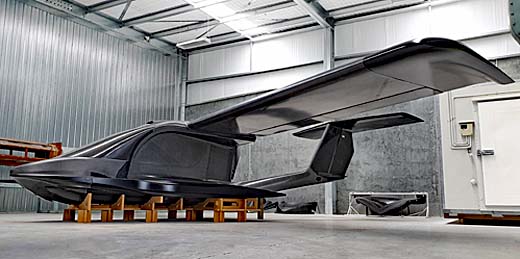 During this time, finishing touches put into the manuals and processes ensure that Vickers meets all of its regulatory requirements. "We are using technology to do it smarter and quicker," said Paul. "Vickers is creating a paperless work environment from engineering to the manufacturing facility to customer support. Ensuring that all data is generated and stored electronically cuts down on development time and physical storage space while providing improved levels of control of the build of individual parts and aircraft." Vickers notes use of portable electronic devices such as phones and tablets to allow staff to directly monitor the manufacturing equipment such as ovens and freezers. This technology also enables the approval of work and the ordering of parts and materials electronically.
"The benefits to the customer are that our team can quickly retrieve this data both onsite and offsite, immediately understanding the configuration of any aircraft we have built" said Paul. "This provides accurate and fast response times to customers anywhere in the world. There will be no more needing to wait until the office opens in the morning." That will be valuable as New Zealand operates on a very different time than, for example, the USA.
During this time, finishing touches put into the manuals and processes ensure that Vickers meets all of its regulatory requirements. "We are using technology to do it smarter and quicker," said Paul. "Vickers is creating a paperless work environment from engineering to the manufacturing facility to customer support. Ensuring that all data is generated and stored electronically cuts down on development time and physical storage space while providing improved levels of control of the build of individual parts and aircraft." Vickers notes use of portable electronic devices such as phones and tablets to allow staff to directly monitor the manufacturing equipment such as ovens and freezers. This technology also enables the approval of work and the ordering of parts and materials electronically.
"The benefits to the customer are that our team can quickly retrieve this data both onsite and offsite, immediately understanding the configuration of any aircraft we have built" said Paul. "This provides accurate and fast response times to customers anywhere in the world. There will be no more needing to wait until the office opens in the morning." That will be valuable as New Zealand operates on a very different time than, for example, the USA.
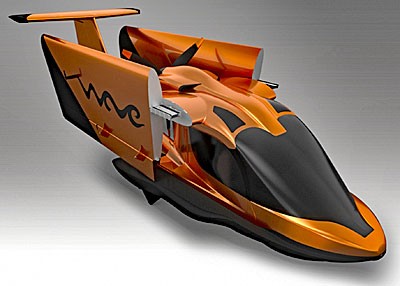
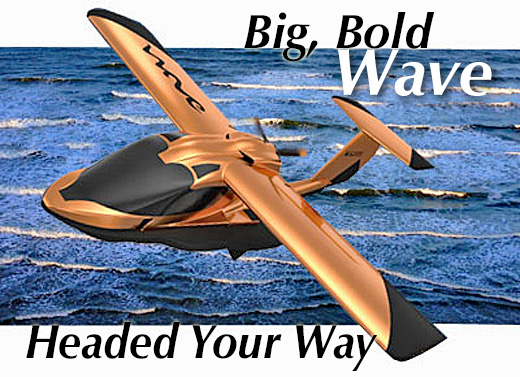
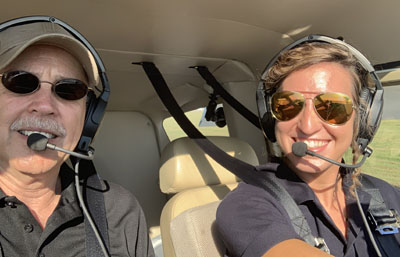
 The idea is that since you could not go aloft in Colt I wanted to do what you'd have done had you been at Midwest LSA Expo (which I hope you will be next year; it is simply perfect for demonstration flights… the best of any airshow we attend). Through many years of experience, I have learned to start these Video Pilot Reports by asking the factory pilot to show me exactly what they'd show you if you were the one sitting in my seat.
Karin did that, so we ran through taxiing, basic takeoff and climb to altitude, followed by maneuvers. We did cruise speed evaluations, slow flight, and stalls. After she showed me what Colt could do, I requested the controls and I performed my usual evaluation starting with some dutch rolls, a non-aerobatic exercise I use to learn the handling characteristics. If I can do reasonably coordinated dutch rolls pretty quickly, as I did in Colt, that tells me this is a well-handling flying machine.
The idea is that since you could not go aloft in Colt I wanted to do what you'd have done had you been at Midwest LSA Expo (which I hope you will be next year; it is simply perfect for demonstration flights… the best of any airshow we attend). Through many years of experience, I have learned to start these Video Pilot Reports by asking the factory pilot to show me exactly what they'd show you if you were the one sitting in my seat.
Karin did that, so we ran through taxiing, basic takeoff and climb to altitude, followed by maneuvers. We did cruise speed evaluations, slow flight, and stalls. After she showed me what Colt could do, I requested the controls and I performed my usual evaluation starting with some dutch rolls, a non-aerobatic exercise I use to learn the handling characteristics. If I can do reasonably coordinated dutch rolls pretty quickly, as I did in Colt, that tells me this is a well-handling flying machine.
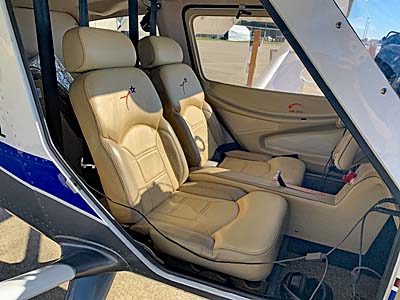 Unlike most LSA, Colt uses a yoke rather than conventional or side stick. I'm a joystick lover but I acknowledge most pilots trained in the last few decades may be more comfortable with a yoke. Some prefer it so much they will tell you an airplane is easer to handle with a yoke. I think it's a personal preference but if you prefer a yoke, Texas Aircraft's Colt is one that may please you.
Colt is an all-aluminum construction, meaning any repair work needed after a purchase can be done by a great many mechanics anywhere in the world. It is powered by the
Unlike most LSA, Colt uses a yoke rather than conventional or side stick. I'm a joystick lover but I acknowledge most pilots trained in the last few decades may be more comfortable with a yoke. Some prefer it so much they will tell you an airplane is easer to handle with a yoke. I think it's a personal preference but if you prefer a yoke, Texas Aircraft's Colt is one that may please you.
Colt is an all-aluminum construction, meaning any repair work needed after a purchase can be done by a great many mechanics anywhere in the world. It is powered by the 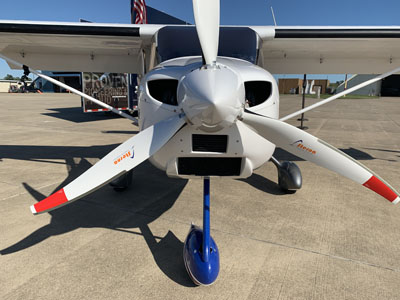 Colt's aluminum skin — fuselage, wings, tail, and control surfaces — is supported by a welded chromoly steel safety cell. The construction techniques have been proven by designer Caio Jordão's model from a different company called Conquest 180. Jordão's work has resulted in more than 300 planes that have amassed 150,000 flight hours. His son Diego assists him.
In final form, Colt will offer cruise at about 110 knots though we saw less at lower altitudes and without final optimization of prop and engine, plus the added prototype weight.
Stalls occurred at very slow speeds — high 30 knots to low 40 knots indicated air speeds — and were all very well behaved. In all maneuvering that I did, Colt felt very solid and secure. It should be a great aircraft choice for those who want that classic Cessna experience in a Light-Sport Aircraft.
Colt's aluminum skin — fuselage, wings, tail, and control surfaces — is supported by a welded chromoly steel safety cell. The construction techniques have been proven by designer Caio Jordão's model from a different company called Conquest 180. Jordão's work has resulted in more than 300 planes that have amassed 150,000 flight hours. His son Diego assists him.
In final form, Colt will offer cruise at about 110 knots though we saw less at lower altitudes and without final optimization of prop and engine, plus the added prototype weight.
Stalls occurred at very slow speeds — high 30 knots to low 40 knots indicated air speeds — and were all very well behaved. In all maneuvering that I did, Colt felt very solid and secure. It should be a great aircraft choice for those who want that classic Cessna experience in a Light-Sport Aircraft.
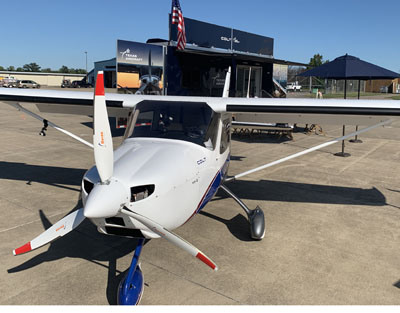
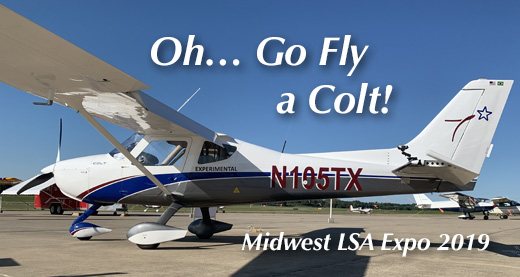
 If SuperSport looks familiar to you, it should. It's based on the CTSW but joins several elements of the newer CTLS. In Europe, Flight Design has continued to deliver a lighter model from the CT series to conform to the microlight or European ultralight parameters.
SuperSport is something fresh as it takes a CTSW fuselage and grafts on the CTLS wing; adapts construction from the CTLS gear while still doing it with a single piece, like CTSW; employs tail structure from the newer model; and drafts the
If SuperSport looks familiar to you, it should. It's based on the CTSW but joins several elements of the newer CTLS. In Europe, Flight Design has continued to deliver a lighter model from the CT series to conform to the microlight or European ultralight parameters.
SuperSport is something fresh as it takes a CTSW fuselage and grafts on the CTLS wing; adapts construction from the CTLS gear while still doing it with a single piece, like CTSW; employs tail structure from the newer model; and drafts the 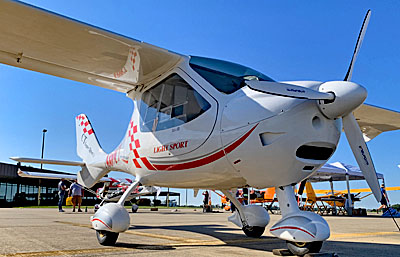 CT SuperSport can be delivered with a 710 pound empty weight that puts it well below many Light-Sport Aircraft and more than 100 pounds lighter than the longer CTLS. "This weight reduction was accomplished by using simplified avionics and equipment plus some lighter parts from the European version of the CT," said Flight Design.
CT SuperSport has the same spacious and wide interior of the CT series but it returns to the "mushroom" instrument panel that does not extend all the way to the cockpit exterior. Seeming to rise out of the floor, you know, like a mushroom, the panel produces a feeling of much greater visibility, especially forward.
Re-entering the CTSW cabin reminded me of the helicopter-like vision afforded by the cockpit design. This came in handy while I flew with the
CT SuperSport can be delivered with a 710 pound empty weight that puts it well below many Light-Sport Aircraft and more than 100 pounds lighter than the longer CTLS. "This weight reduction was accomplished by using simplified avionics and equipment plus some lighter parts from the European version of the CT," said Flight Design.
CT SuperSport has the same spacious and wide interior of the CT series but it returns to the "mushroom" instrument panel that does not extend all the way to the cockpit exterior. Seeming to rise out of the floor, you know, like a mushroom, the panel produces a feeling of much greater visibility, especially forward.
Re-entering the CTSW cabin reminded me of the helicopter-like vision afforded by the cockpit design. This came in handy while I flew with the 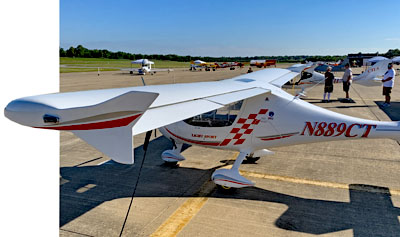 CT SuperSport is some 13 inches shorter than CTLS, Tom Jr. noted and it does not have the hat rack or aft cabin windows of CTLS. CT SuperSport also uses an electric trim for pitch only while CTLS has pitch, aileron, and rudder trim by wheels.
The new, lighter CT model is what I'd agree to call a performance model. It runs close to the top end of the permitted speed range, can fly around 1,000 statute miles, climbs 1,000 feet per minute, yet sips fuel at rates of four gallons per hour, even less if you retard the throttle slightly. It is a lively handling aircraft that still exhibits mild stall characteristics proven by our performing a full regimen of approach and departure stalls plus accelerated stalls in each direction.
Base price of CT SuperSport is: $135,000, some $40,000 less than the flagship CTLS. "Options include night flight equipment and autopilot with Level button," said Flight Design.
CT SuperSport is some 13 inches shorter than CTLS, Tom Jr. noted and it does not have the hat rack or aft cabin windows of CTLS. CT SuperSport also uses an electric trim for pitch only while CTLS has pitch, aileron, and rudder trim by wheels.
The new, lighter CT model is what I'd agree to call a performance model. It runs close to the top end of the permitted speed range, can fly around 1,000 statute miles, climbs 1,000 feet per minute, yet sips fuel at rates of four gallons per hour, even less if you retard the throttle slightly. It is a lively handling aircraft that still exhibits mild stall characteristics proven by our performing a full regimen of approach and departure stalls plus accelerated stalls in each direction.
Base price of CT SuperSport is: $135,000, some $40,000 less than the flagship CTLS. "Options include night flight equipment and autopilot with Level button," said Flight Design.
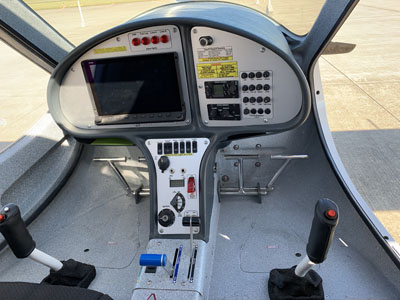 Father and son Gutmanns run
Father and son Gutmanns run  You have two more days of
You have two more days of 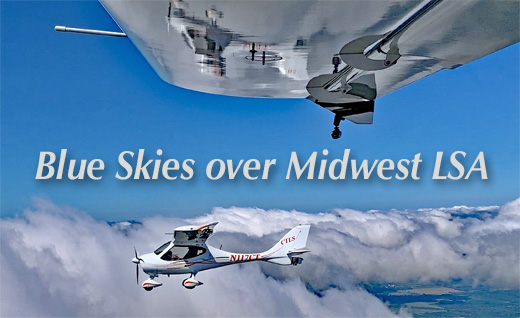
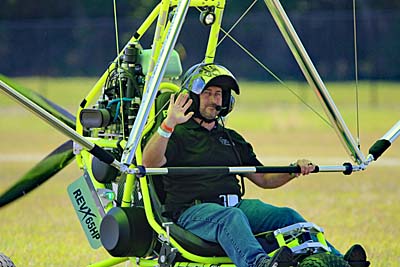 Larry Mednick is a happily married man now but he remains a restless designer, always striving for a new variation on the exquisite theme he started with Revo ten years ago.
Since the
Larry Mednick is a happily married man now but he remains a restless designer, always striving for a new variation on the exquisite theme he started with Revo ten years ago.
Since the 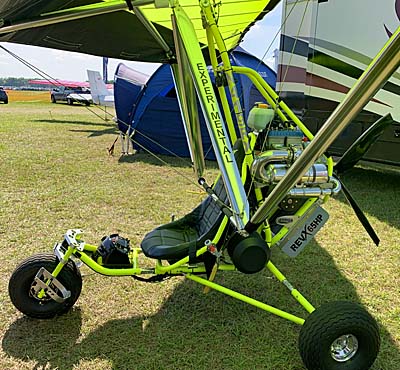 Finally comes RevX. Larry said about Rev that it is a delightful trike that he has thoroughly enjoyed since it was released four years ago. However, it is a calm weather flyer. I see nothing wrong with that but the lightweight airframe of Rev means it is somewhat more vulnerable should conditions pick up strength.
Enter RevX. Larry said three attributes distinguish the newest in his "Rev" line. RevX still folds in six minutes flat and, yes, Evolution has video to prove it (plus see our video below). That system was developed with Rev but when Larry says it folds up he also means it can be transported this way. Rev and RevX both fold quickly while still supporting the structure completely. Most trikes fold up (although few do so as fast) but once folded the wings are not perfectly supported by structure that was purpose-designed to do so.
RevX also brings full suspension to the Rev-type design. This was not reasonable on Rev as it tried to stay within the tight constraints of Part 103's 254-pound empty weight (before emergency parachutes or floats, for which extra pounds are allowed).
Third, RevX shares with Rev the wide-open visibility of having no structural forward strut. Many trike observers think that forward strut is no visual impediment, but they may not have flown a fully-open trike like Rev or RevX. Evolution designed their structure so that the forward strut was not necessary and double value is achieved when the forward strut need not be removed to facilitate fold-down.
Finally comes RevX. Larry said about Rev that it is a delightful trike that he has thoroughly enjoyed since it was released four years ago. However, it is a calm weather flyer. I see nothing wrong with that but the lightweight airframe of Rev means it is somewhat more vulnerable should conditions pick up strength.
Enter RevX. Larry said three attributes distinguish the newest in his "Rev" line. RevX still folds in six minutes flat and, yes, Evolution has video to prove it (plus see our video below). That system was developed with Rev but when Larry says it folds up he also means it can be transported this way. Rev and RevX both fold quickly while still supporting the structure completely. Most trikes fold up (although few do so as fast) but once folded the wings are not perfectly supported by structure that was purpose-designed to do so.
RevX also brings full suspension to the Rev-type design. This was not reasonable on Rev as it tried to stay within the tight constraints of Part 103's 254-pound empty weight (before emergency parachutes or floats, for which extra pounds are allowed).
Third, RevX shares with Rev the wide-open visibility of having no structural forward strut. Many trike observers think that forward strut is no visual impediment, but they may not have flown a fully-open trike like Rev or RevX. Evolution designed their structure so that the forward strut was not necessary and double value is achieved when the forward strut need not be removed to facilitate fold-down.
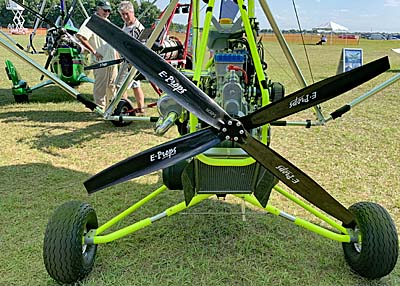 However, in exchange for some building effort RevX buyers will get a quite capable trike with impressive performance.
"Another big change is that the wing on RevX is 25% smaller than on Rev. The RevX wing is 12.0 square meters (129 square feet) with a 28 foot span, where Rev's Part 103 wing is 15 square meters (161 square feet) with a 31.5 foot span," clarified Larry. The higher wing loading makes for crisp handling but more windspeed capability than the more lightly loaded Rev.
A smaller but still single-surface wing is paired with the much more potent
However, in exchange for some building effort RevX buyers will get a quite capable trike with impressive performance.
"Another big change is that the wing on RevX is 25% smaller than on Rev. The RevX wing is 12.0 square meters (129 square feet) with a 28 foot span, where Rev's Part 103 wing is 15 square meters (161 square feet) with a 31.5 foot span," clarified Larry. The higher wing loading makes for crisp handling but more windspeed capability than the more lightly loaded Rev.
A smaller but still single-surface wing is paired with the much more potent  "The single surface RevX wing has a limited speed range," Larry explained. "Pilots will see stall at 28 mph, normal cruise at 45 mph and the wing maxes out at 58 mph," he noted but the handling of a single surface wing is superior.
As you'll see in the video, not only is Larry a gifted trike pilot but the machine seems willing to allow handling to delight most trike pilots.
"The single surface RevX wing has a limited speed range," Larry explained. "Pilots will see stall at 28 mph, normal cruise at 45 mph and the wing maxes out at 58 mph," he noted but the handling of a single surface wing is superior.
As you'll see in the video, not only is Larry a gifted trike pilot but the machine seems willing to allow handling to delight most trike pilots.
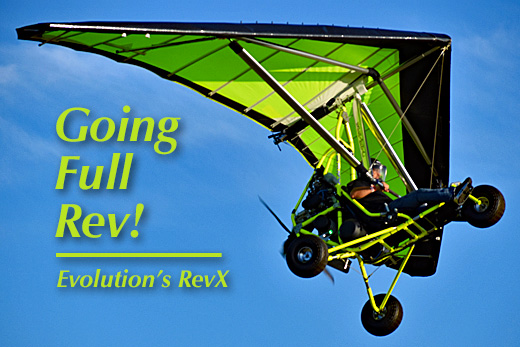
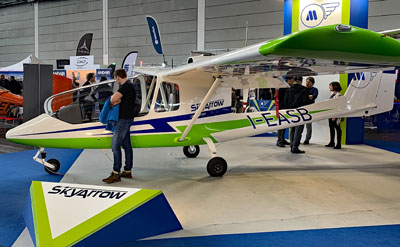 Sky Arrow producer
Sky Arrow producer 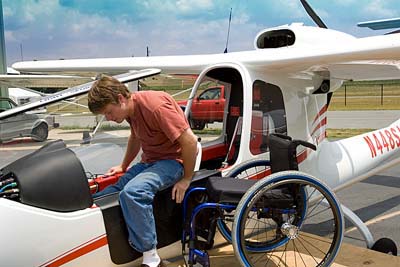 Thanks to his work with more good folks at
Thanks to his work with more good folks at 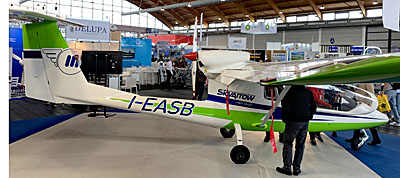 No wonder Sky Arrow was able to win Part 23 approval for Sky Arrow. This achievement is unusual because — at least until the rewritten Part 23 becomes law — the process that put tens of thousands of GA airplanes in the air has been breathtakingly expensive. Cirrus claimed the effort took tens of millions of dollars after the design work was completed. That's too expensive for LSA builders. If you think some LSA are too costly now, let me try assure you that they would have far higher prices if they had to meet Part 23.
Yet, here we have Sky Arrow, with full Part 23 approval accepted by FAA.
No wonder Sky Arrow was able to win Part 23 approval for Sky Arrow. This achievement is unusual because — at least until the rewritten Part 23 becomes law — the process that put tens of thousands of GA airplanes in the air has been breathtakingly expensive. Cirrus claimed the effort took tens of millions of dollars after the design work was completed. That's too expensive for LSA builders. If you think some LSA are too costly now, let me try assure you that they would have far higher prices if they had to meet Part 23.
Yet, here we have Sky Arrow, with full Part 23 approval accepted by FAA.
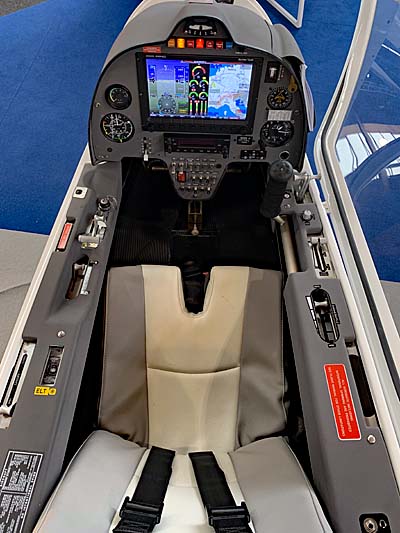 As most of the industry waits for FAA to complete their work, Sky Arrow USA has some luxury of time to plant their seeds.
Helping seeds grow is something Sky Arrow USA is presently focused on like a laser beam. Agricultural use of Sky Arrow is a present goal for U.S-built models.
"We have completed paperwork for a production certificate," said Marco Cavazzoni, Chairman of Sky Arrow USA. "Next we'll build a conforming aircraft and validate our build process and our facility." He is serious about manufacturing in America, but this is not the stretch it has been for other would-be U.S. builders.
Magnaghi Aeronautica is a "minority partner" of Sky Arrow USA, Marco clarified. Since the Italian manufacturer is a shareholder, the U.S. operation is in control of the design, a key requirement for FAA to consider a U.S. operation to be the official manufacturer of a design. This is essential as it allows them to make changes as needed to quickly address market desires.
"For the LSA market, we are nearly ready. We are creating a sales team and seeking distributors for all the Americas from the north of Canada to the tip of South America."
At the same time, their Part 23 aircraft focus is on "precision agriculture," Marco noted. This employs a system where sophisticated sensors, cameras, and technology aids the pilot to spray crops with great exactness. "Our technology can direct the spray system where to spread, where not to spray, and it can log places where the farmer needs to inspect more carefully."
As most of the industry waits for FAA to complete their work, Sky Arrow USA has some luxury of time to plant their seeds.
Helping seeds grow is something Sky Arrow USA is presently focused on like a laser beam. Agricultural use of Sky Arrow is a present goal for U.S-built models.
"We have completed paperwork for a production certificate," said Marco Cavazzoni, Chairman of Sky Arrow USA. "Next we'll build a conforming aircraft and validate our build process and our facility." He is serious about manufacturing in America, but this is not the stretch it has been for other would-be U.S. builders.
Magnaghi Aeronautica is a "minority partner" of Sky Arrow USA, Marco clarified. Since the Italian manufacturer is a shareholder, the U.S. operation is in control of the design, a key requirement for FAA to consider a U.S. operation to be the official manufacturer of a design. This is essential as it allows them to make changes as needed to quickly address market desires.
"For the LSA market, we are nearly ready. We are creating a sales team and seeking distributors for all the Americas from the north of Canada to the tip of South America."
At the same time, their Part 23 aircraft focus is on "precision agriculture," Marco noted. This employs a system where sophisticated sensors, cameras, and technology aids the pilot to spray crops with great exactness. "Our technology can direct the spray system where to spread, where not to spray, and it can log places where the farmer needs to inspect more carefully."
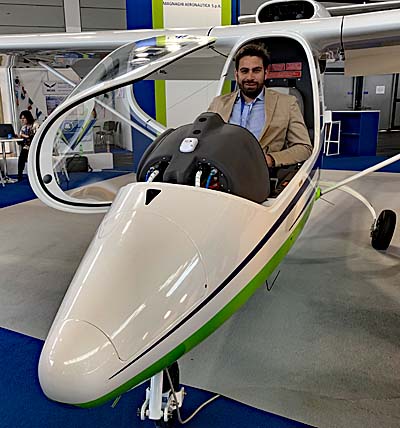 The big difference here is that Sky Arrow may get in the business years ahead of other LSA players because Magnaghi already has Part 23 approval so they can perform commercial operations years before a manufacturer wanting to do so with a Light-Sport Aircraft model. "Also, because our airframe is tested to a 2x factor of safety, where most aircraft meet a 1.5x factor, we can carry the loads and do the work with greater assurance," Marco explained.
"We basically have a Part 23 aircraft operating at LSA weights and speeds. We offer a sturdy aircraft that can deliver the goods while also providing a stable, secure platform to do the imaging that is a big part of precision agricultural work."
While the working capability of Sky Arrow should help the company grow their business, it is the sheer joy of flight that will attract buyers to Sky Arrow. Watch for U.S. rep Marco Cavazzoni at airshows in 2020 and take a flight when you can. You may not smile as broadly as Able Flight's scholarship winners, but I'm betting you will love the experience.
Examine the aircraft more fully and come along for a flight in the subject aircraft in this short video…
https://youtu.be/UQ_PklduEvw
The big difference here is that Sky Arrow may get in the business years ahead of other LSA players because Magnaghi already has Part 23 approval so they can perform commercial operations years before a manufacturer wanting to do so with a Light-Sport Aircraft model. "Also, because our airframe is tested to a 2x factor of safety, where most aircraft meet a 1.5x factor, we can carry the loads and do the work with greater assurance," Marco explained.
"We basically have a Part 23 aircraft operating at LSA weights and speeds. We offer a sturdy aircraft that can deliver the goods while also providing a stable, secure platform to do the imaging that is a big part of precision agricultural work."
While the working capability of Sky Arrow should help the company grow their business, it is the sheer joy of flight that will attract buyers to Sky Arrow. Watch for U.S. rep Marco Cavazzoni at airshows in 2020 and take a flight when you can. You may not smile as broadly as Able Flight's scholarship winners, but I'm betting you will love the experience.
Examine the aircraft more fully and come along for a flight in the subject aircraft in this short video…
https://youtu.be/UQ_PklduEvw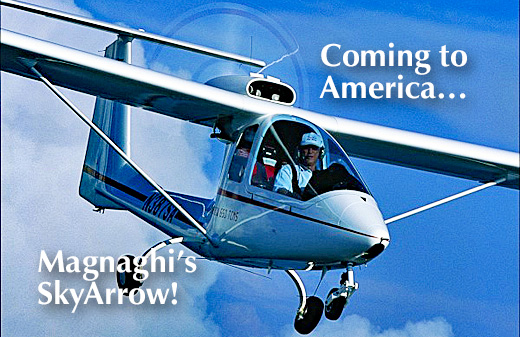
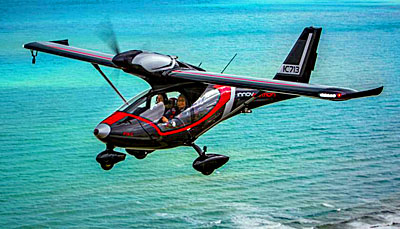 If you are an ultralight enthusiast (as I certainly am!), then you are probably celebrating with me as FX1 joins the Special LSA fleet — which it does as Number 150 on our popular
If you are an ultralight enthusiast (as I certainly am!), then you are probably celebrating with me as FX1 joins the Special LSA fleet — which it does as Number 150 on our popular 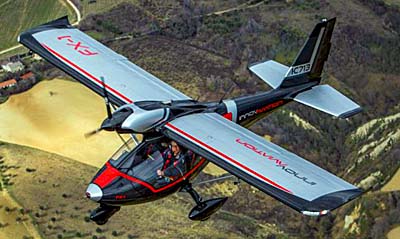 The older JetFox models were more clearly ultralights. These were European ultralights, which are somewhere between a Part 103 ultralight vehicle and LSA of today.
The design always caught my eye and I very much enjoyed flying the late '90s model. However, I did not enjoy worming my way into the cockpit around tubing structure and throwing a leg over the stick. You needed to be something of a contortionist to enter and I did not do so very gracefully.
Times change. Along came modern LSA in all manner of aircraft and along came carbon fiber, digital instrumentation, crashworthy designs, and modern engines like Rotax's 912iS. Longtime JetFox/FX1 designer Alfredo di Cesare made incremental changes to the JetFox series but he kept aware of the changing design of light aircraft and moved forward with an entirely fresh creation. Virtually every part of
The older JetFox models were more clearly ultralights. These were European ultralights, which are somewhere between a Part 103 ultralight vehicle and LSA of today.
The design always caught my eye and I very much enjoyed flying the late '90s model. However, I did not enjoy worming my way into the cockpit around tubing structure and throwing a leg over the stick. You needed to be something of a contortionist to enter and I did not do so very gracefully.
Times change. Along came modern LSA in all manner of aircraft and along came carbon fiber, digital instrumentation, crashworthy designs, and modern engines like Rotax's 912iS. Longtime JetFox/FX1 designer Alfredo di Cesare made incremental changes to the JetFox series but he kept aware of the changing design of light aircraft and moved forward with an entirely fresh creation. Virtually every part of 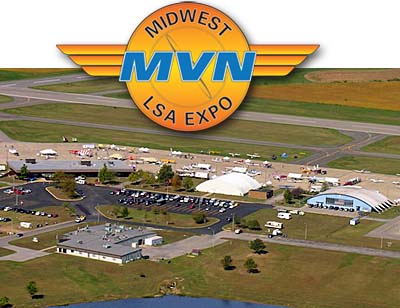 Chris created the
Chris created the 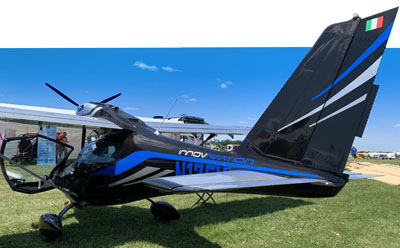 "At the controls were southern California-based reps for the aircraft, Pete Schutte and Deon Lombard. In the post-flight photograph are (from left to right) Deon Lombard,
"At the controls were southern California-based reps for the aircraft, Pete Schutte and Deon Lombard. In the post-flight photograph are (from left to right) Deon Lombard, 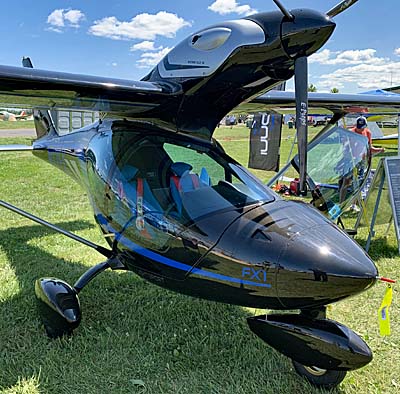 I've already bought my ticket and will be on hand all three days of the Midwest LSA Expo. I hope you can make it, as well.
MWLSA is located about an hour's drive east of St. Louis. The airport is all LSA, Sport Pilot kits, and ultralights for the show days. You can visit with about 40 aircraft vendors (weather permitting and it usually is good) and you can take a demo flight in mere minutes.
The airport has forums, air conditioned inside displays, food, regular bathrooms, and a ramp full of fun airplanes. The town has plenty of restaurants and hotels, all reasonably priced.
What's not to love?
Here's a short video image about FX1 at Oshkosh and Mt. Vernon. Enjoy!
I've already bought my ticket and will be on hand all three days of the Midwest LSA Expo. I hope you can make it, as well.
MWLSA is located about an hour's drive east of St. Louis. The airport is all LSA, Sport Pilot kits, and ultralights for the show days. You can visit with about 40 aircraft vendors (weather permitting and it usually is good) and you can take a demo flight in mere minutes.
The airport has forums, air conditioned inside displays, food, regular bathrooms, and a ramp full of fun airplanes. The town has plenty of restaurants and hotels, all reasonably priced.
What's not to love?
Here's a short video image about FX1 at Oshkosh and Mt. Vernon. Enjoy!
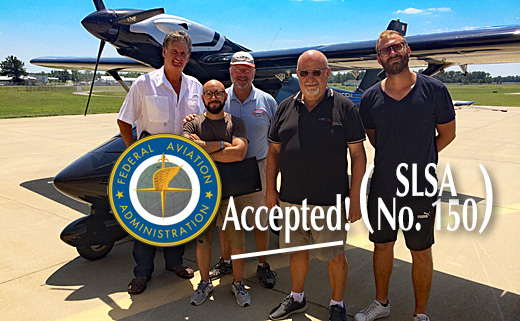
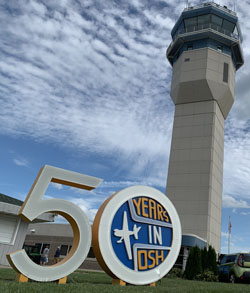 EAA announced attendance numbers identifying solid growth over last year, to 642,000 attendees
EAA announced attendance numbers identifying solid growth over last year, to 642,000 attendees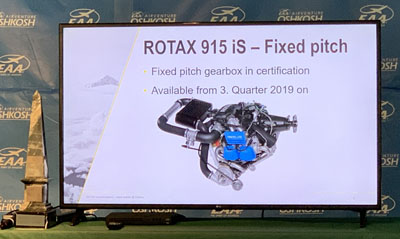 True to form as you might expect,
True to form as you might expect, 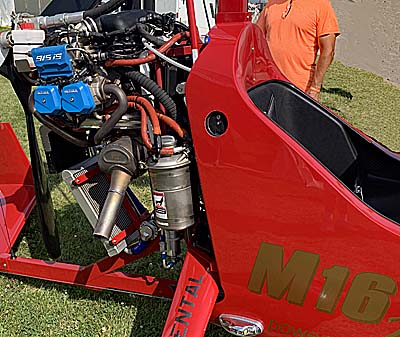
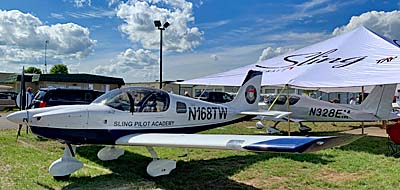 What's interesting here is that both companies have exclusively made low wing models in various configuration. Neither has made a high wing. One of these is also planning the new, powerful Rotax 915iS engine (though both producers are using that power plant in one of the low wing models.
For more on the entry from South Africa's
What's interesting here is that both companies have exclusively made low wing models in various configuration. Neither has made a high wing. One of these is also planning the new, powerful Rotax 915iS engine (though both producers are using that power plant in one of the low wing models.
For more on the entry from South Africa's 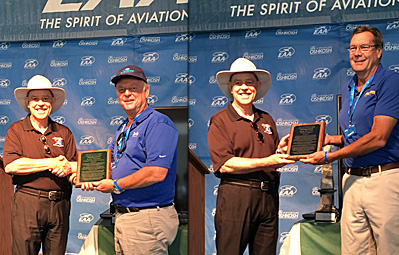
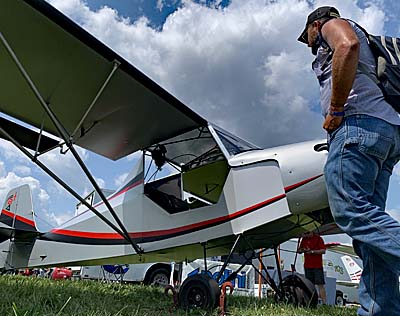
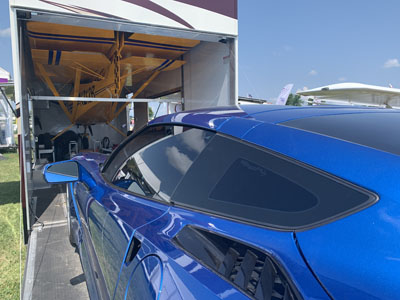 I hope I didn’t drool on it as I looked it over.
Built for recreation, this highly-customized trailer is towed behind the owner’s motorhome. It can hold his Aerotrek A240, requiring the tricycle gear model so as to fit the owners Corvette underneath. A clever system of ramps and winches allows him to load the aircraft and the car with no assistance. Both sides also open up to make it easier to stow the airplane ramps once the aircraft is secured and to allow proper tie-down of the Corvette.
As a former Corvette owner, a former motorhome owner, and a lover of the Aerotrek aircraft, this setup looked to be about as close to aviation heaven as mere mortals can get. So, this apparatus gets my award for the Coolest Rig seen at the show.
I hope I didn’t drool on it as I looked it over.
Built for recreation, this highly-customized trailer is towed behind the owner’s motorhome. It can hold his Aerotrek A240, requiring the tricycle gear model so as to fit the owners Corvette underneath. A clever system of ramps and winches allows him to load the aircraft and the car with no assistance. Both sides also open up to make it easier to stow the airplane ramps once the aircraft is secured and to allow proper tie-down of the Corvette.
As a former Corvette owner, a former motorhome owner, and a lover of the Aerotrek aircraft, this setup looked to be about as close to aviation heaven as mere mortals can get. So, this apparatus gets my award for the Coolest Rig seen at the show.
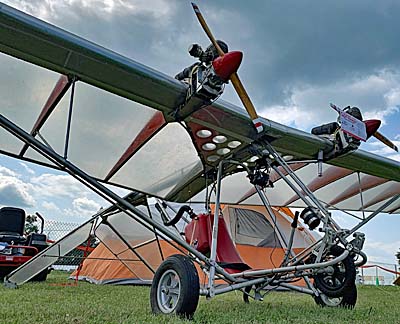
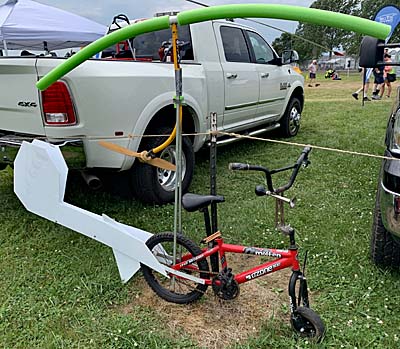
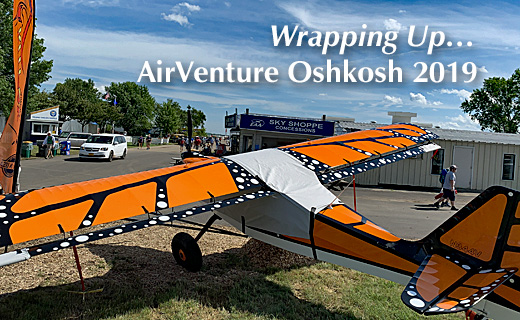
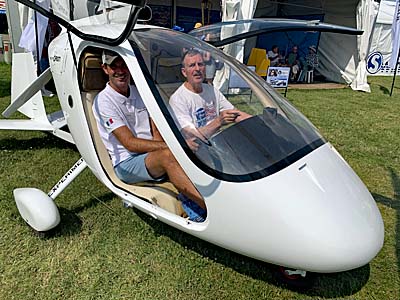 How well is the category doing in other parts of the world? The answer draws on reports from dominant engine producer, Rotax Aircraft Engines, which has reported for years that the class of aircraft buying the most engines has been gyroplanes. Considering the many fixed wing designs also use that engine brand, Rotax's statement carries tremendous weight.
The story about why gyroplanes were denied the full privileges of Special LSA — and therefore have to be built as Experimental Amateur Built (EAB) kits in America — is a long, sad story …but it is one that appears to be ending, thank goodness!
As described in this
How well is the category doing in other parts of the world? The answer draws on reports from dominant engine producer, Rotax Aircraft Engines, which has reported for years that the class of aircraft buying the most engines has been gyroplanes. Considering the many fixed wing designs also use that engine brand, Rotax's statement carries tremendous weight.
The story about why gyroplanes were denied the full privileges of Special LSA — and therefore have to be built as Experimental Amateur Built (EAB) kits in America — is a long, sad story …but it is one that appears to be ending, thank goodness!
As described in this 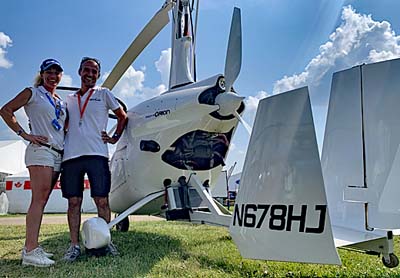
 Orion's instrument panel is equipped with rotor revolution counter, altimeter, air-speed indicator, vertical compass, a digital engine monitoring system, and fuel level gauge. Additional, optional instrumentation can be added as desired.
For controls, Orion offers full dual joystick and pedals for each occupant. Standard equipment includes electric trim.
M24 Orion is attractive and roomy inside. For carriage, Orion is equipped with three easily-accessed baggage compartments. Its cabin heating system combined with full enclosure allows M24 to remain comfortable even on cold winter days.
From either seat the view is enormous, a key benefit of gyroplanes without nearby wing structure to block your view. Orion would definitely be more comfortable for long flights or in chilly weather but the open cockpit M16 Trainer or M22 Voyager models deliver an even more expansive view.
Combined with a gyroplane's unique handling and performance, these machines make wonderful viewing platforms.
Orion's instrument panel is equipped with rotor revolution counter, altimeter, air-speed indicator, vertical compass, a digital engine monitoring system, and fuel level gauge. Additional, optional instrumentation can be added as desired.
For controls, Orion offers full dual joystick and pedals for each occupant. Standard equipment includes electric trim.
M24 Orion is attractive and roomy inside. For carriage, Orion is equipped with three easily-accessed baggage compartments. Its cabin heating system combined with full enclosure allows M24 to remain comfortable even on cold winter days.
From either seat the view is enormous, a key benefit of gyroplanes without nearby wing structure to block your view. Orion would definitely be more comfortable for long flights or in chilly weather but the open cockpit M16 Trainer or M22 Voyager models deliver an even more expansive view.
Combined with a gyroplane's unique handling and performance, these machines make wonderful viewing platforms.
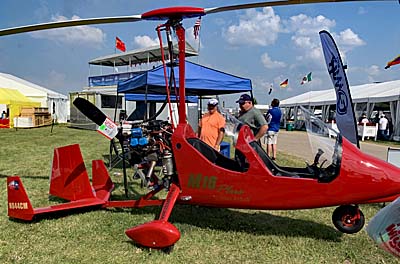 "An innovative and avant-garde choice," Magni said, "[915iS] brings to the whole range a considerable increase in cruising and climbing performance, with fuel consumption comparable to the Rotax 914."
One of Magni's American customers, identified only as M.B., wrote the company to say, “As the proud owner of the first Magni M16 Plus in the USA, I can tell you the performance is like none other. Takeoff, climb and speed performance exceeded my expectations. This gyroplane has incredible power reserve, more than enough for every aspect of flight. Takeoffs are breathtaking, cruise is smooth and landings are gentle. The Magni M16 Plus is an incredible flying machine!”
One final comment of worthy note: In late 2016, the Magni Gyro factory in Besnate, Italy produced the company’s 1,000th gyroplane.
See lots of video experiences in Magni gyros at
"An innovative and avant-garde choice," Magni said, "[915iS] brings to the whole range a considerable increase in cruising and climbing performance, with fuel consumption comparable to the Rotax 914."
One of Magni's American customers, identified only as M.B., wrote the company to say, “As the proud owner of the first Magni M16 Plus in the USA, I can tell you the performance is like none other. Takeoff, climb and speed performance exceeded my expectations. This gyroplane has incredible power reserve, more than enough for every aspect of flight. Takeoffs are breathtaking, cruise is smooth and landings are gentle. The Magni M16 Plus is an incredible flying machine!”
One final comment of worthy note: In late 2016, the Magni Gyro factory in Besnate, Italy produced the company’s 1,000th gyroplane.
See lots of video experiences in Magni gyros at 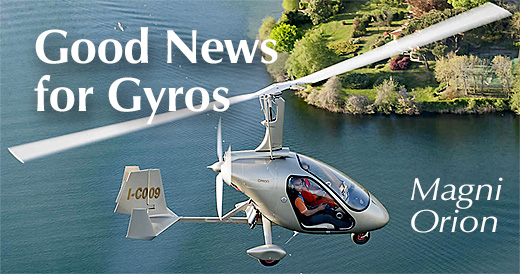
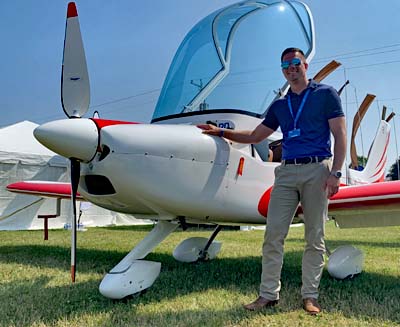
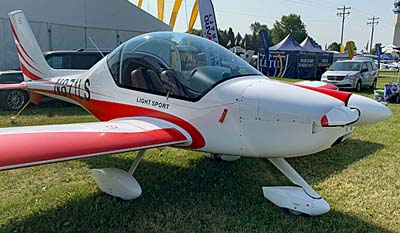 The design appears connected to the Fly Synthesis Texan from Italy and the designer reportedly assisted Sunward as they worked on this project. Yet a glance at the Texan (at bottom) shows numerous differences
The design appears connected to the Fly Synthesis Texan from Italy and the designer reportedly assisted Sunward as they worked on this project. Yet a glance at the Texan (at bottom) shows numerous differences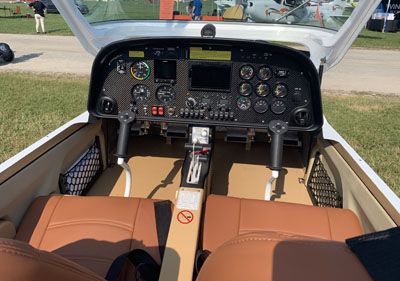 All these differences suggest that if Aurora is a Texan, it is an improvement on the original. The company said Aurora is the first Chinese brand Light-Sport Aircraft to receive Chinese (CAAC) airworthiness certification.
Aurora is "designed and manufactured under the full supervision and instruction of foreign experts," clarified Sunward. They believe their performance and quality is comparable to other advanced international brands in this market.
Aurora is nose to tail carbon fiber, uses the Rotax 912, and will offer U.S. instrumentation. Pricing is competitive with a higher end LSA in the range of $160,000.
The company and their U.S. associates at Sunward USA in Plano, Texas will gain a great deal of feedback at Oshkosh 2019 and many people got their first glimpse of an attractive aircraft from China.
All these differences suggest that if Aurora is a Texan, it is an improvement on the original. The company said Aurora is the first Chinese brand Light-Sport Aircraft to receive Chinese (CAAC) airworthiness certification.
Aurora is "designed and manufactured under the full supervision and instruction of foreign experts," clarified Sunward. They believe their performance and quality is comparable to other advanced international brands in this market.
Aurora is nose to tail carbon fiber, uses the Rotax 912, and will offer U.S. instrumentation. Pricing is competitive with a higher end LSA in the range of $160,000.
The company and their U.S. associates at Sunward USA in Plano, Texas will gain a great deal of feedback at Oshkosh 2019 and many people got their first glimpse of an attractive aircraft from China.

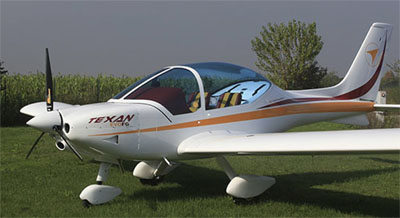
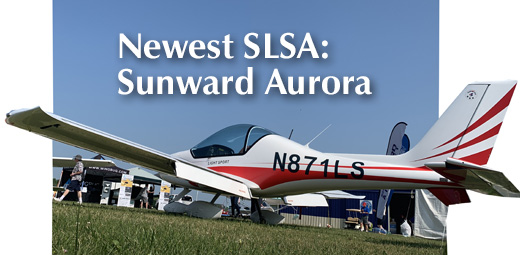
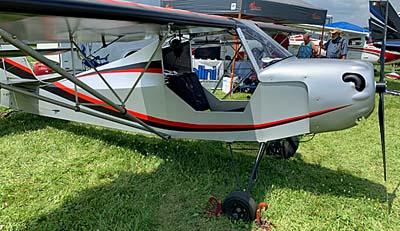 A good marketer Denney's Kitfox once employed a whole staff of sales people following up on loads of leads that the then-new design was generating. Even now, decades later, Kitfox, doing business as
A good marketer Denney's Kitfox once employed a whole staff of sales people following up on loads of leads that the then-new design was generating. Even now, decades later, Kitfox, doing business as 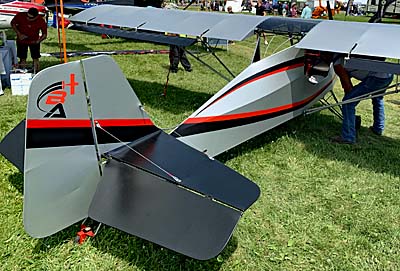 "I've been involved with autos and motorcycles my whole life," Chris detailed, "but I had a passion for aviation. When the chance came to acquire the Kitfox Lite, I jumped." With other family members, Chris established his company and set to building Kitfox Lite as a series of differently configured models… F1 UL base kit, F2 Flyer, F3 Speed, F4 Monster, and F5 Fujita. Each model step comes with addition features or equipment." Yet, as Badland advises, "Every model is 100% Part 103 capable." In fact, the aircraft at Oshkosh 2019 (nearby photos) weighed a mere 235 pounds, generously under the Part 103 limits of 254 pounds empty.
Chris seems determined and proud to protect this ultralight vehicle. "It is our honor to carry the tradition of this Dan Denney design into the future," said Chris.
"I've been involved with autos and motorcycles my whole life," Chris detailed, "but I had a passion for aviation. When the chance came to acquire the Kitfox Lite, I jumped." With other family members, Chris established his company and set to building Kitfox Lite as a series of differently configured models… F1 UL base kit, F2 Flyer, F3 Speed, F4 Monster, and F5 Fujita. Each model step comes with addition features or equipment." Yet, as Badland advises, "Every model is 100% Part 103 capable." In fact, the aircraft at Oshkosh 2019 (nearby photos) weighed a mere 235 pounds, generously under the Part 103 limits of 254 pounds empty.
Chris seems determined and proud to protect this ultralight vehicle. "It is our honor to carry the tradition of this Dan Denney design into the future," said Chris.
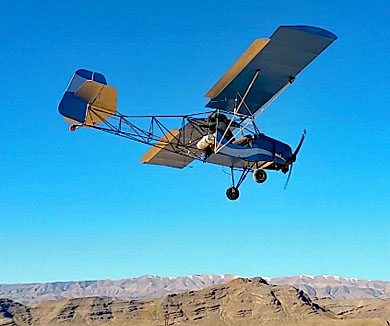 "Expect to spend anywhere between $11,700-$28,500 for a brand spanking new Badland kit," said Chris, the owner of Badland Aircraft. "You can expect to spend another $2,000-$4,500 for the firewall forward parts unless you have an engine laying around."
However, as Chris puts it, "$35,000 will get you one of the baddest bush-style ultralights in existence." Referring to the F5 Fujita he asked, "Who wouldn’t love a full titanium airframe, 21-inch bush tires, 8-inches of suspension travel, a 60 horsepower ultralight that can take you anywhere you want to go? The deluxe model is not ready at this time, but Chris said they were moving with the project.
"A ready to fly base model F-1 starts at $18,900 and runs to the top of the line F-5 built with full titanium welded cage, 58 horsepower yet still 100% Part 103 Ultralight legal," said Badland. "[This is] our dream machine, with every option to make you feel on top of the world; for $37,000 we’ve got you covered."
"Expect to spend anywhere between $11,700-$28,500 for a brand spanking new Badland kit," said Chris, the owner of Badland Aircraft. "You can expect to spend another $2,000-$4,500 for the firewall forward parts unless you have an engine laying around."
However, as Chris puts it, "$35,000 will get you one of the baddest bush-style ultralights in existence." Referring to the F5 Fujita he asked, "Who wouldn’t love a full titanium airframe, 21-inch bush tires, 8-inches of suspension travel, a 60 horsepower ultralight that can take you anywhere you want to go? The deluxe model is not ready at this time, but Chris said they were moving with the project.
"A ready to fly base model F-1 starts at $18,900 and runs to the top of the line F-5 built with full titanium welded cage, 58 horsepower yet still 100% Part 103 Ultralight legal," said Badland. "[This is] our dream machine, with every option to make you feel on top of the world; for $37,000 we’ve got you covered."
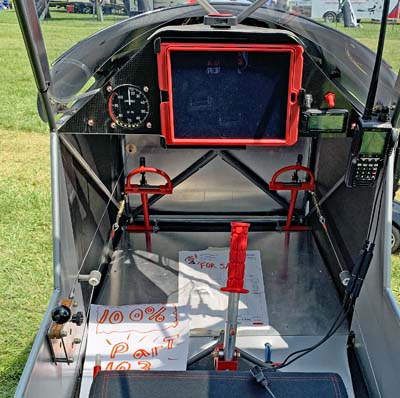 "With the folding wings and the ability to park it in a 20 foot by 8.5 foot enclosed car trailer or a single car garage, you’ll appreciate the versatility."
What I examined at Oshkosh 2019 looked good with many quality machined parts and an attention to detail you could see in several places. Badland may be new but Kitfox Lite is known and accepted. I think we'll be seeing more of Badland Aircraft.
"With the folding wings and the ability to park it in a 20 foot by 8.5 foot enclosed car trailer or a single car garage, you’ll appreciate the versatility."
What I examined at Oshkosh 2019 looked good with many quality machined parts and an attention to detail you could see in several places. Badland may be new but Kitfox Lite is known and accepted. I think we'll be seeing more of Badland Aircraft.
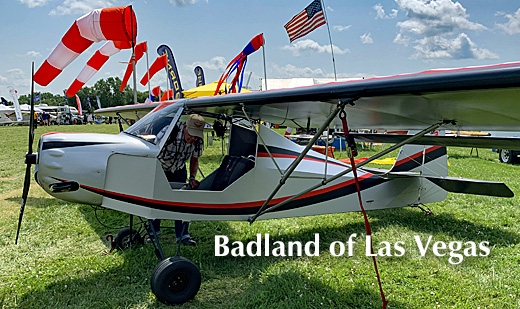
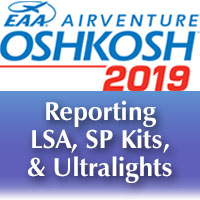 After impressing European pilots at the big German show called Aero Friedrichshafen, producer InnovAviation brought their sleek and sexy FX1 for Americans to see at Oshkosh 2019. For American representation, the Italian producer will be teaming up with Deon Lombard, who also represents the
After impressing European pilots at the big German show called Aero Friedrichshafen, producer InnovAviation brought their sleek and sexy FX1 for Americans to see at Oshkosh 2019. For American representation, the Italian producer will be teaming up with Deon Lombard, who also represents the 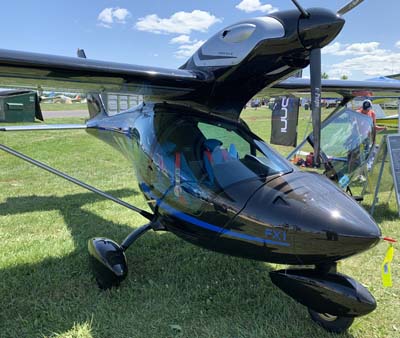 I can't imagine how anyone can look at Alfredo Di Cesare's creation and not react with admiration. Italian companies are known for dashing and innovative lines (think: Ferrari or any number of auto companies or LSA giant, Tecnam). Design talent is definitely not lacking from Italian products; FX1 should be an object of national pride.
The FX1 is an evolved fourth-generation aircraft following the JetFox 97 from the 1990s. Designed by Alfredo Di Cesare, a noted aircraft designer with over 35 years of experience in the sport-plane industry, FX1 is clearly related to the earlier model but it is so different in many ways that it is unfair to compare them directly.
I can't imagine how anyone can look at Alfredo Di Cesare's creation and not react with admiration. Italian companies are known for dashing and innovative lines (think: Ferrari or any number of auto companies or LSA giant, Tecnam). Design talent is definitely not lacking from Italian products; FX1 should be an object of national pride.
The FX1 is an evolved fourth-generation aircraft following the JetFox 97 from the 1990s. Designed by Alfredo Di Cesare, a noted aircraft designer with over 35 years of experience in the sport-plane industry, FX1 is clearly related to the earlier model but it is so different in many ways that it is unfair to compare them directly.
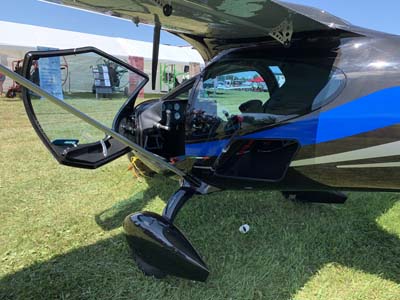 Sitting in FX1 at Oshkosh, it is immediately clear this is not the JetFox97. The older model was much more challenging to enter as you had to contort your body to wriggle around structure. Once in it was comfortable but the all-new FX1 is far easier partly thanks to those shapely curved doors.
FX1 is a welded steel structure with a carbon fiber skin. During an Oshkosh video interview we learned the carbon fiber skin can be completely removed in about one and half hours when, for example, you may need to do a very thorough inspection.
Some aircraft that evolved from similar design can have rather awkward engine mounts, commonly with exposed engines. While I see nothing wrong with that — and they are certainly easy to inspect and maintain — Alfredo's has smoothly encased the fuel injected
Sitting in FX1 at Oshkosh, it is immediately clear this is not the JetFox97. The older model was much more challenging to enter as you had to contort your body to wriggle around structure. Once in it was comfortable but the all-new FX1 is far easier partly thanks to those shapely curved doors.
FX1 is a welded steel structure with a carbon fiber skin. During an Oshkosh video interview we learned the carbon fiber skin can be completely removed in about one and half hours when, for example, you may need to do a very thorough inspection.
Some aircraft that evolved from similar design can have rather awkward engine mounts, commonly with exposed engines. While I see nothing wrong with that — and they are certainly easy to inspect and maintain — Alfredo's has smoothly encased the fuel injected 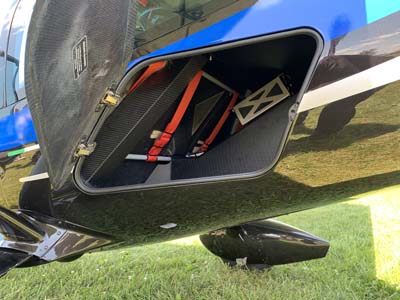 A luggage compartment aft of the cockpit has access doors on each side and the space is open side to side giving ample area for items you wish to transport to your destination. For things you might want in flight, a space behind the occupant's heads is available. Seats are comfortable and the cockpit measures a broad 49 inches wide (almost 10 inches more than a Cessna 172).
In the side-by-side seats, FX1 features handsome side sticks on the outside of each seat. A single throttle is center mounted. All controls are within an easy reach.
Visibility is enormous, with occupants surrounded by perhaps 300 degrees of clear acrylic. The Rotax engine above and in front of the cockpit is almost out of sight and only very marginally impedes your vision, less so than most engines on the nose of an aircraft.
"FX1 delivers ease of flying, comfort, safety, ruggedness, durability, attractive styling and exceptional performance across the board," boasted the company. For more,
A luggage compartment aft of the cockpit has access doors on each side and the space is open side to side giving ample area for items you wish to transport to your destination. For things you might want in flight, a space behind the occupant's heads is available. Seats are comfortable and the cockpit measures a broad 49 inches wide (almost 10 inches more than a Cessna 172).
In the side-by-side seats, FX1 features handsome side sticks on the outside of each seat. A single throttle is center mounted. All controls are within an easy reach.
Visibility is enormous, with occupants surrounded by perhaps 300 degrees of clear acrylic. The Rotax engine above and in front of the cockpit is almost out of sight and only very marginally impedes your vision, less so than most engines on the nose of an aircraft.
"FX1 delivers ease of flying, comfort, safety, ruggedness, durability, attractive styling and exceptional performance across the board," boasted the company. For more, 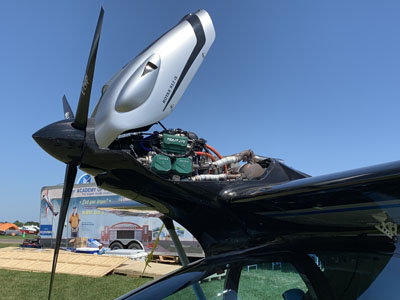
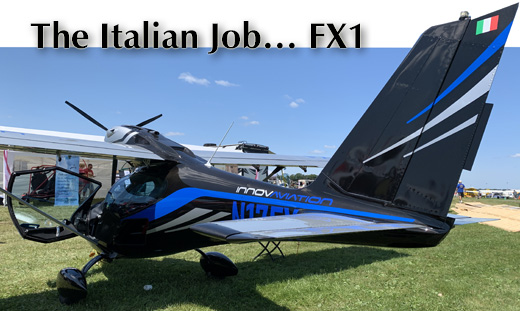
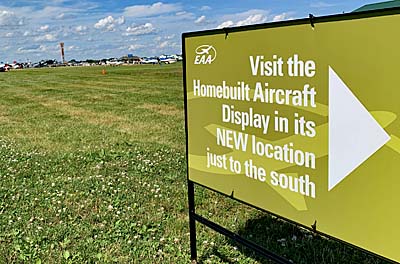 Cruising the grounds at Oshkosh, looking for aircraft to report, I looked around the all-new Homebuilt Area. This group has long occupied a fairly spacious grassy area in a good location south of the Warbirds Area, said to be Oshkosh's biggest draw. However, for 2019 EAA relocated the area bringing vendors closer to the densest customer traffic, which may encourage more attendees to examine their aircraft. Several exhibitors I spoke to seemed content with the new location.
The new area had the usual collection of vendors, many of which qualify as Sport Pilot kits that can be flown with the certificate that needs no aviation medical. Quarters looked rather tight compared to past years, with airplanes somewhat shoehorned into the allocated space. Like all changes — and EAA has made a huge number of them in the fifty years the event has been held in Oshkosh — visitors and vendors will adapt quickly enough and soon we'll forget the old "North 40" where homebuilt kits once displayed.
As I strolled through the new area, I passed by
Cruising the grounds at Oshkosh, looking for aircraft to report, I looked around the all-new Homebuilt Area. This group has long occupied a fairly spacious grassy area in a good location south of the Warbirds Area, said to be Oshkosh's biggest draw. However, for 2019 EAA relocated the area bringing vendors closer to the densest customer traffic, which may encourage more attendees to examine their aircraft. Several exhibitors I spoke to seemed content with the new location.
The new area had the usual collection of vendors, many of which qualify as Sport Pilot kits that can be flown with the certificate that needs no aviation medical. Quarters looked rather tight compared to past years, with airplanes somewhat shoehorned into the allocated space. Like all changes — and EAA has made a huge number of them in the fifty years the event has been held in Oshkosh — visitors and vendors will adapt quickly enough and soon we'll forget the old "North 40" where homebuilt kits once displayed.
As I strolled through the new area, I passed by 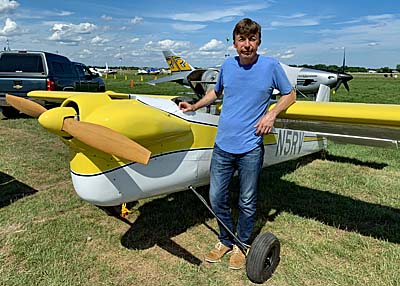 Truthfully, Van's Aircraft Vice President and Chief Engineer Rian Johnson is only displaying a personal project. RV-5 was never offered for sale and won't be now. Yet the light aircraft enthusiast in me noticed it right away. Probably like most other attendees I wondered, "What is that?
"Of course, we want people to focus on our current popular kits such as RV-8, -10, and -12," quickly added, "but I thought Oshkosh visitors might enjoy seeing a bit of Van's history." RV-5 dates way back to 1975 when it was built by Dick VanGrunsven and EAA 105 chapter members to evaluate several design concepts. Among the goals of the group, Rian explained, were light weight and fuel efficiency. RV-5 was never intended for production.
RV-5's wings swing back over the flat aft fuselage for easier transport or more space-efficient storage. No control linkages need be disconnected thanks to a clever center-mounted mixer that stays in place when folding the wings.
Truthfully, Van's Aircraft Vice President and Chief Engineer Rian Johnson is only displaying a personal project. RV-5 was never offered for sale and won't be now. Yet the light aircraft enthusiast in me noticed it right away. Probably like most other attendees I wondered, "What is that?
"Of course, we want people to focus on our current popular kits such as RV-8, -10, and -12," quickly added, "but I thought Oshkosh visitors might enjoy seeing a bit of Van's history." RV-5 dates way back to 1975 when it was built by Dick VanGrunsven and EAA 105 chapter members to evaluate several design concepts. Among the goals of the group, Rian explained, were light weight and fuel efficiency. RV-5 was never intended for production.
RV-5's wings swing back over the flat aft fuselage for easier transport or more space-efficient storage. No control linkages need be disconnected thanks to a clever center-mounted mixer that stays in place when folding the wings.
 "Some years back, I was up in a loft storage area looking for something and uncovered a dusty airframe. When I asked Dick about it, he asked, 'Do you want it?' Be careful what you ask for," Rian noted although he did eventually tackle the restoration project marrying the airframe of RV-5 to the canopy of RV-2.
The single seat design is small. A very lean Rian said he weighs 138 pounds and RV-5 is even somewhat snug for him so this is not an aircraft for pilots who tip the scales beyond FAA's 170-pound reference weight. That hardly matters, however, as this is not an active project for anyone but Rian.
Needing only 40 horsepower to perform enthusiastically RV-5 is powered by a
"Some years back, I was up in a loft storage area looking for something and uncovered a dusty airframe. When I asked Dick about it, he asked, 'Do you want it?' Be careful what you ask for," Rian noted although he did eventually tackle the restoration project marrying the airframe of RV-5 to the canopy of RV-2.
The single seat design is small. A very lean Rian said he weighs 138 pounds and RV-5 is even somewhat snug for him so this is not an aircraft for pilots who tip the scales beyond FAA's 170-pound reference weight. That hardly matters, however, as this is not an active project for anyone but Rian.
Needing only 40 horsepower to perform enthusiastically RV-5 is powered by a 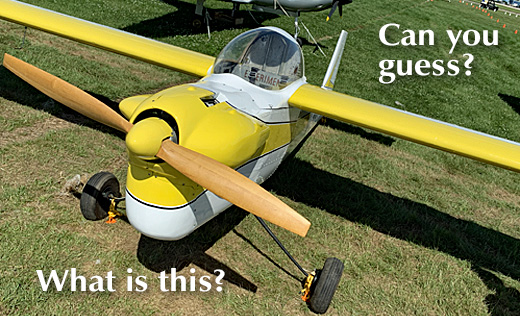
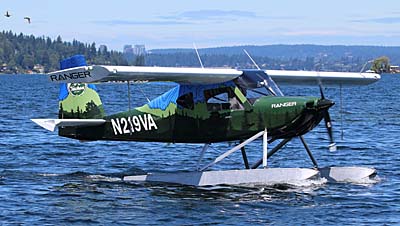 While organized as completely separate companies, Vashon shares common ownership through the name John Torode, the founder of Dynon Avionics. The two businesses work hard to stay separate but it's clear one success might help the other just as John's earlier success in the tech industry lead to Dynon being formed.
When you
While organized as completely separate companies, Vashon shares common ownership through the name John Torode, the founder of Dynon Avionics. The two businesses work hard to stay separate but it's clear one success might help the other just as John's earlier success in the tech industry lead to Dynon being formed.
When you  Estimated production numbers in 2019, if this is something you wish to divulge.
Estimated production numbers in 2019, if this is something you wish to divulge.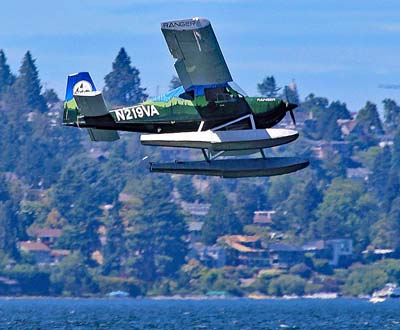 Is the R7 only for those interested in Sport Pilot/LSA?
Is the R7 only for those interested in Sport Pilot/LSA?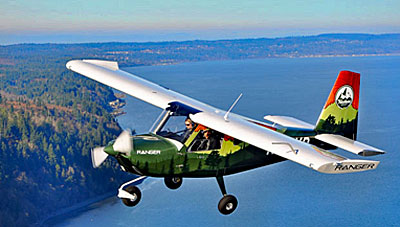 Anecdotes from customers/operators and how you have addressed requests/problems (the true indicator of excellence).
Anecdotes from customers/operators and how you have addressed requests/problems (the true indicator of excellence).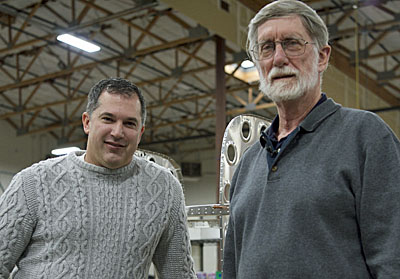 Where is your exhibit located and who will a person meet there?
Where is your exhibit located and who will a person meet there?